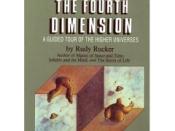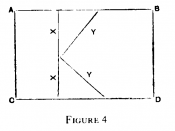Living in a three-dimensional world does not enable one to visualize or physically experience anything more than three dimensions. Some people believe that because of this time, "a non-spatial continuum in which events occur in apparently irreversible succession from the past through the present to the future" is a strong candidate for the 4th dimension, while others believe it can't be visualized or physically experienced so it is not (Dictionary). Though opinions may differ, it is an exciting topic to explore. Flatland is a very thoughtful story that will no doubt spark the imagination of almost all who read it and possibly enable some to see a vision of fourth dimension.
Flatland, written by Edwin A. Abbot in 1884 is an incredibly unusual novel. It is a fantasy type journey through the mathematical world of dimensions with the main character, A. Square as the tour guide. Though never directly addressed, but due to the content of the story, it seems to take place in the future and spans over a period of many months.
The story takes place in three settings; Flatland, Spaceland, and Lineland. Flatland is a world of two dimensions, Spaceland, which is also referred to as Thoughtland is three dimensions, and Lineland is one dimension. For the majority of the novel Flatland is the surrounding. A. Square is a four-sided polygon, which in Flatland is a professional man, and is one of two significant characters in the novel. The other is A. Sphere from Space land, and a king (longest line) from Line land. The first half of the novel describes the inhabitants of Flatland, including lines (women), isosceles triangles (soldiers and lowest class workmen), equilateral triangles (middle class men), squares and pentagons (professional men and gentlemen), hexagons and heptagons (nobility), and circles ("priests"...


